Tourism towards Sustainability and Innovation: A Systematic Literature Review
Abstract
:1. Introduction
2. Methodology
3. Bibliometric Analysis
- a.
- The design methodology approach keyword has a connection with the keywords originality value, model, innovation, study, sustainability, and tourism keywords.
- b.
- The originality value keyword has a connection with the keywords design methodology approach, model, factor, and sustainability.
- c.
- The model keyword has a connection with the keywords design methodology approach, originality value, factor, study, innovation, sustainability, tourism, article, and destination.
- d.
- The innovation keyword has a connection with the keywords design methodology approach, model, sustainability, model, tourism, factor, article, and destination.
- e.
- The study keyword has a connection with the keywords design methodology approach, model, innovation, sustainability, factor, tourism, destination, and article.
- f.
- The sustainability keyword has a connection with the keywords originality value, design methodology approach, innovation, model, study, tourism, article, and destination.
- g.
- The factor keyword has a connection with the keywords model, study, innovation, tourism, destination, and article.
- h.
- The tourism keyword has a connection with the keywords design methodology approach, originality value, model, study, innovation, sustainability, factor, destination, and article.
- i.
- The destination keyword has a connection with the keywords factor, model, sustainability, study, innovation, tourism, and article.
- j.
- Finally, the article keyword has a connection with the keywords factor, destination, model, tourism, study, sustainability, and innovation.
4. Results
4.1. Sustainability in Tourism
4.2. Innovation in Tourism
4.3. Categories of Sustainability and Innovation in Tourism
5. Conclusions
Author Contributions
Funding
Institutional Review Board Statement
Informed Consent Statement
Data Availability Statement
Conflicts of Interest
References
- UNWTO. World Tourism Barometer; Madrid: United Nations. Available online: https://doi.org/10.18111/wtobarometereng (accessed on 10 October 2020).
- Zolfani, S.H.; Sedaghat, M.; Maknoon, R.; Kazimieras Zavadskas, E.K. Sustainable tourism: A comprehensive literature review on frameworks and applications. Econ. Res. Ekon. Istraživanja 2015, 28, 1–30. [Google Scholar] [CrossRef] [Green Version]
- UNWTO. 2017 is the international year of sustainable tourism for development. Available online: http://www.unwto.org/archive/global/press-release/2017-01-03/2017-international-year-sustainabletourism-development (accessed on 10 October 2017).
- UNWTO. Economic Impact of Travel and Tourism Report. Available online: https://www.wttc.org/ (accessed on 10 October 2020).
- Waseema, M. Enhancing destination competitiveness for a sustainable tourism industry: The case of Maldives. OIDA Int. J. Sustain. Dev. 2017, 10, 11–24. [Google Scholar]
- Pjerotic, L.; Delibasic, M.; Joksiene, I.; Griesiene, I.; Georgeta, C.P. Sustainable tourism development in the rural areas. Transform. Bus. Econ. 2017, 16, 21–30. [Google Scholar]
- Knox-Hayes, J.; Chandra, S.; Chun, J. The role of values in shaping sustainable development perspectives and outcomes: A case study of Iceland. Sustain. Dev. 2020, 29, 1–15. [Google Scholar]
- Niñerola, A.; Sánchez-Rebull, M.V.; Hernández-Lara, A.B. Tourism research on sustainability: A bibliometric analysis. Sustainability 2019, 11, 1377. [Google Scholar] [CrossRef] [Green Version]
- Streimikiene, D.; Svagzdiene, B.; Jasinskas, E.; Simanavicius, A. Sustainable tourism development and competitiveness: The systematic literature review. Sustain. Dev. 2020, 29, 259–271. [Google Scholar] [CrossRef]
- World Travel and Tourism Council. Economic Impact Reports. Available online: https://wttc.org/Research/Economic-Impact (accessed on 10 October 2021).
- Moher, D.; Liberati, A.; Tetzlaff, J.; Altman, D.G. Preferred reporting items for systematic reviews and meta-analyses: The PRISMA statement. PLoS Med. 2009, 6, e1000097. [Google Scholar] [CrossRef] [Green Version]
- Alderson, P.; Green, S.; Higgins, J.P.T. Cochrane Reviewers’ Handbook 4.2.2 (updated March 2004). In The Cochrane Library, 1st ed.; John Wiley & Sons, Ltd.: Chichester, UK, 2004. [Google Scholar]
- Font, X.; McCabe, S. Sustainability and marketing in tourism: Its contexts, paradoxes, approaches, challenges and potential. J. Sust. Tour. 2017, 25, 869–883. [Google Scholar] [CrossRef] [Green Version]
- Koch, J.; Gerdt, S.-O.; Schewe, G. Determinants of sustainable behavior of firms and the consequences for customer satisfaction in hospitality. Int. J. Hosp. Manag. 2020, 89, 102515. [Google Scholar] [CrossRef]
- Garay, L.; Font, X.; Pereira-Moliner, J. Understanding sustainability behaviour: The relationship between information acquisition, proactivity and performance. Tour. Manag. 2017, 60, 418–429. [Google Scholar] [CrossRef] [Green Version]
- Mauri, C. What comes to mind when you think of sustainability? Qualitative research with ZMET. World. Hosp. Tour. Them. 2020, 12, 459–470. [Google Scholar] [CrossRef]
- Elmo, G.C.; Arcese, G.; Valeri, M.; Poponi, S.; Pacchera, F. Sustainability in Tourism as an Innovation Driver: An Analysis of Family Business Reality. Sustainability 2020, 12, 6149. [Google Scholar] [CrossRef]
- González-Serrano, M.H.; Añó Sanz, V.; González-García, R.J. Sustainable Sport Entrepreneurship and Innovation: A Bibliometric Analysis of This Emerging Field of Research. Sustainability 2020, 12, 5209. [Google Scholar] [CrossRef]
- Karagiannis, D.; Metaxas, T. Sustainable Wine Tourism Development: Case Studies from the Greek Region of Peloponnese. Sustainability 2020, 12, 5223. [Google Scholar] [CrossRef]
- Eskerod, P.; Hollensen, S.; Morales-Contreras, M.F.; Arteaga-Ortiz, J. Drivers for Pursuing Sustainability through IoT Technology within High-End Hotels—An Exploratory Study. Sustainability 2019, 11, 5372. [Google Scholar] [CrossRef] [Green Version]
- Chung, N.; Tyan, I.; Lee, S.J. Eco-Innovative Museums and Visitors’ Perceptions of Corporate Social Responsibility. Sustainability 2019, 11, 5744. [Google Scholar] [CrossRef] [Green Version]
- Pizzi, S.; Caputo, A.; Corvino, A.; Venturelli, A. Management research and the UN sustainable development goals (SDGs): A bibliometric investigation and systematic review. J. Clean. Prod. 2020, 276, 124033. [Google Scholar] [CrossRef]
- Tritto, A. Environmental management practices in hotels at world heritage sites. J. Sustain. Tour. 2020, 28, 1911–1931. [Google Scholar] [CrossRef]
- López, M.F.B.; Virto, N.R.; Manzano, J.A.; Garcia-Madariaga, J. Tourism sustainability in archaeological sites. J. Cult. Heritage. Manag. Sustain. Dev. 2018, 8, 276–292. [Google Scholar] [CrossRef]
- Dias, A.; Silva, G.M.; Patuleia, M.; González-Rodríguez, M.R. Developing sustainable business models: Local knowledge acquisition and tourism lifestyle entrepreneurship. J. Sustain. Tour. 2020, 1–20. [Google Scholar] [CrossRef]
- Fennell, D.A.; Bowyer, E. Tourism and Sustainable transformation: A discussion and application to tourism food consumption. Tour. Recreat. Res. 2019, 45, 119–131. [Google Scholar] [CrossRef]
- Henche, B.G.; Salvaj, E.; Cuesta-Valiño, P. A Sustainable Management Model for Cultural Creative Tourism Ecosystems. Sustainability 2020, 12, 9554. [Google Scholar] [CrossRef]
- Flores, S.S.; Medeiros, R.M.V. A framework proposal for sustainability management in wine industry. Int. J. Innov. Sustain. Dev. 2019, 13, 348–375. [Google Scholar] [CrossRef]
- Raub, S.P.; Martin-Rios, C. “Think sustainable, act local”–a stakeholder-filter-model for translating SDGs into sustainability initiatives with local impact. Int. J. Contemp. Hosp. Manag. 2019, 31, 2428–2447. [Google Scholar] [CrossRef]
- Seraphin, H.; Thanh, T.V. Investigating the application of the Principles for Responsible Management Education to resort mini-clubs. Int. J. Manag. Educ. 2020, 18, 100377. [Google Scholar] [CrossRef]
- Peters, S.; Font, X.; Bonilla-Priego, M.J. Why organizations join voluntary sustainable tourism associations: Implications for membership and sustainability monitoring systems. Int. J. Tour. Res. 2019, 22, 325–335. [Google Scholar] [CrossRef]
- Agyeiwaah, E.; McKercher, B.; Suntikul, W. Identifying core indicators of sustainable tourism: A path forward? Tour. Manag. Persp. 2017, 24, 26–33. [Google Scholar] [CrossRef]
- Foronda-Robles, C.; Galindo-Pérez-de-Azpillaga, L.; Fernández-Tabales, A. Progress and stakes in sustainable tourism: Indicators for smart coastal destinations. J. Sustain. Tour. 2020, 1–20. [Google Scholar] [CrossRef]
- Crespi-Vallbona, M.; Mascarilla-Miró, O. Street art as a sustainable tool in mature tourist destinations: A case study of Barcelona. Int. J. Cult. Policy 2020, 1–15. [Google Scholar] [CrossRef]
- Oliveras-Villanueva, M.; Llach, J.; Perramon, J. Service Quality in Hospitality and the Sustainability Effect: Systematic Literature Review and Future Research Agenda. Sustainability 2020, 12, 8152. [Google Scholar] [CrossRef]
- Pérez-Pineda, F.; Alcaraz, J.M.; Colón, C. Creating sustainable value in the hospitality industry: A (critical) multi-stakeholder study in the Dominican Republic. J. Sustain. Tour. 2017, 25, 1633–1649. [Google Scholar] [CrossRef]
- Martín, J.M.M.; Fernández, J.A.S.; Martín, J.A.R.; Rey, M.S.O. Analysis of Tourism Seasonality as a Factor Limiting the Sustainable Development of Rural Areas. J. Hosp. Tour. Res. 2019, 44, 45–75. [Google Scholar] [CrossRef]
- Cunha, C.; Kastenholz, E.; Carneiro, M.J. Entrepreneurs in rural tourism: Do lifestyle motivations contribute to management practices that enhance sustainable entrepreneurial ecosystems? J. Hosp. Tour. Manag. 2020, 44, 215–226. [Google Scholar] [CrossRef]
- Islam, M.F.; Zhang, J.; Hasan, N. Assessing the adoption of sustainability practices in tourism industry: Insights from a developing country. Bottom Line 2019, 33, 94–115. [Google Scholar] [CrossRef]
- Barrientos-Báez, A.; Caldevilla-Dominguez, D.; Vizcaíno, A.C.; Val, E.G.S. Tourism Sector: Communication and Sustainable Innovation. Revista de Comunicación de la SEECI 2020, 53, 153–173. [Google Scholar] [CrossRef]
- Satta, G.; Spinelli, R.; Parola, F. Is Tourism Going Green? A Literature Review on Green Innovation for Sustainable Tourism. Tour. Anal. 2019, 24, 265–280. [Google Scholar] [CrossRef]
- Sharma, T.; Chen, J.; Liu, W.Y. Eco-innovation in hospitality research (1998-2018): A systematic review. Int. J. Contemp. Hosp. Manag. 2020, 32, 913–933. [Google Scholar] [CrossRef]
- Reyes-Santiago, M.D.R.; Sánchez-Medina, P.S.; Díaz-Pichardo, R. Eco-innovation and organizational culture in the hotel industry. Int. J. Hosp. Manag. 2017, 65, 71–80. [Google Scholar]
- Kuščer, K.; Mihalič, T.; Pechlaner, H. Innovation, sustainable tourism and environments in mountain destination development: A comparative analysis of Austria, Slovenia and Switzerland. J. Sustain. Tour. 2017, 25, 489–504. [Google Scholar] [CrossRef]
- Horng, J.-S.; Liub, C.-H.; Chou, S.-F.; Tsai, C.-Y.; Chung, Y.-C. From innovation to sustainability: Sustainability innovations ofeco-friendly hotels in Taiwan. Int. J. Hosp. Manag. 2017, 63, 44–52. [Google Scholar] [CrossRef]
- Asadi, S.; Pourhashemi, S.O.; Nilashi, M.; Abdullah, R.; Samad, S.; Yadegaridehkordi, E.; Aljojo, N.; Razali, N.S. Investigating influence of green innovation on sustainability performance: A case on Malaysian hotel industry. J. Clean. Prod. 2020, 258, 120860. [Google Scholar] [CrossRef]
- Buijtendijk, H.; Blom, J.; Vermeer, J.; van der Duim, R. Eco-innovation for sustainable tourism transitions as a process of collaborative co-production: The case of a carbon management calculator for the Dutch travel industry. J. Sustain. Tour. 2018, 26, 1222–1240. [Google Scholar] [CrossRef]
- Presenza, A.; Petruzzelli, A.M.; Natalicchio, A. Business Model Innovation for Sustainability. Highlights from the Tourism and Hospitality Industry. Sustainability 2019, 11, 212. [Google Scholar] [CrossRef] [Green Version]
- Bertella, G. Sustainability in wildlife tourism: Challenging the assumptions and imagining alternatives. Tour. Rev. 2019, 74, 246–255. [Google Scholar] [CrossRef]
- Paunović, I.; Dressler, M.; Mamula Nikolić, T.; Popović Pantić, S. Developing a Competitive and Sustainable Destination of the Future: Clusters and Predictors of Successful National-Level Destination Governance across Destination Life-Cycle. Sustainability 2020, 12, 4066. [Google Scholar] [CrossRef]
- Garay, L.; Font, X.; Corrons, A. Sustainability-Oriented Innovation in Tourism: An Analysis Based on the Decomposed Theory of Planned Behavior. J. Travel Res. 2018, 58, 1–15. [Google Scholar] [CrossRef]
- Triantafillidou, E.; Tsiaras, S. Exploring entrepreneurship, innovation and tourism development from a sustainable perspective: Evidence from Greece. J. Int. Bus. Ent. Dev. 2018, 11, 53–64. [Google Scholar] [CrossRef]
- Palmi, P.; Lezzi, G.E. How Authenticity and Tradition Shift into Sustainability and Innovation: Evidence from Italian Agritourism. Int. J. Environ. Res. Public Heal. 2020, 17, 5389. [Google Scholar] [CrossRef] [PubMed]
- Bressan, A.; Pedrini, M. Exploring Sustainable-Oriented innovation within Micro and Small Tourism Firms. Tour. Plan. Dev. 2019, 17, 497–514. [Google Scholar] [CrossRef]
- Warren, C.; Becken, S.; Coghlan, A. Sustainability-oriented Service Innovation: Fourteen-year longitudinal case study of a tourist accommodation provider. J. Sustain. Tour. 2018, 26, 1784–1803. [Google Scholar] [CrossRef]
- Loureiro, A. Innovation and technology – the only answer for sustainable tourism growth. Worldw. Hosp. Tour. Themes 2019, 11, 743–747. [Google Scholar] [CrossRef]
- Herrero Amo, M.D.; De Stefano, M.C. Public–private partnership as an innovative approach for sustainable tourism in Guanacaste, Costa Rica. Worldw. Hosp. Tour. Themes 2019, 11, 130–139. [Google Scholar] [CrossRef]
- Nunes, S.; Cooke, P. New global tourism innovation in a postcoronavirus era. Eur. Plan. Stud. 2020, 29, 1–19. [Google Scholar] [CrossRef]
- Pareto, V. 1906, as cited in Thaler, R.H.; Misbehaving—The Making of Behavioral Economics; Penguin: London, UK, 2016. [Google Scholar]
- Harari, Y.N. Sapiens—A Brief History of Humankind; Penguin: London, UK, 2011. [Google Scholar]
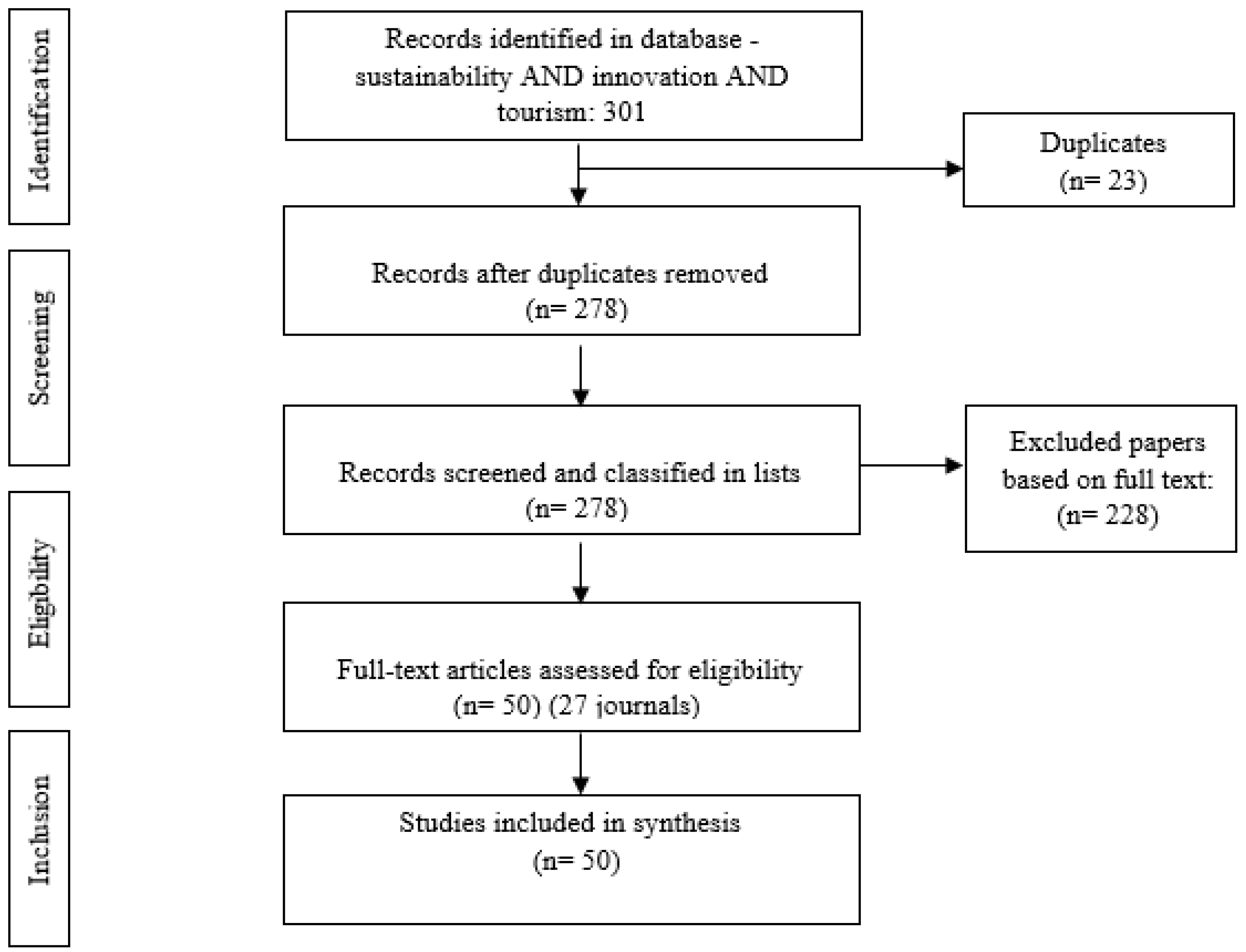
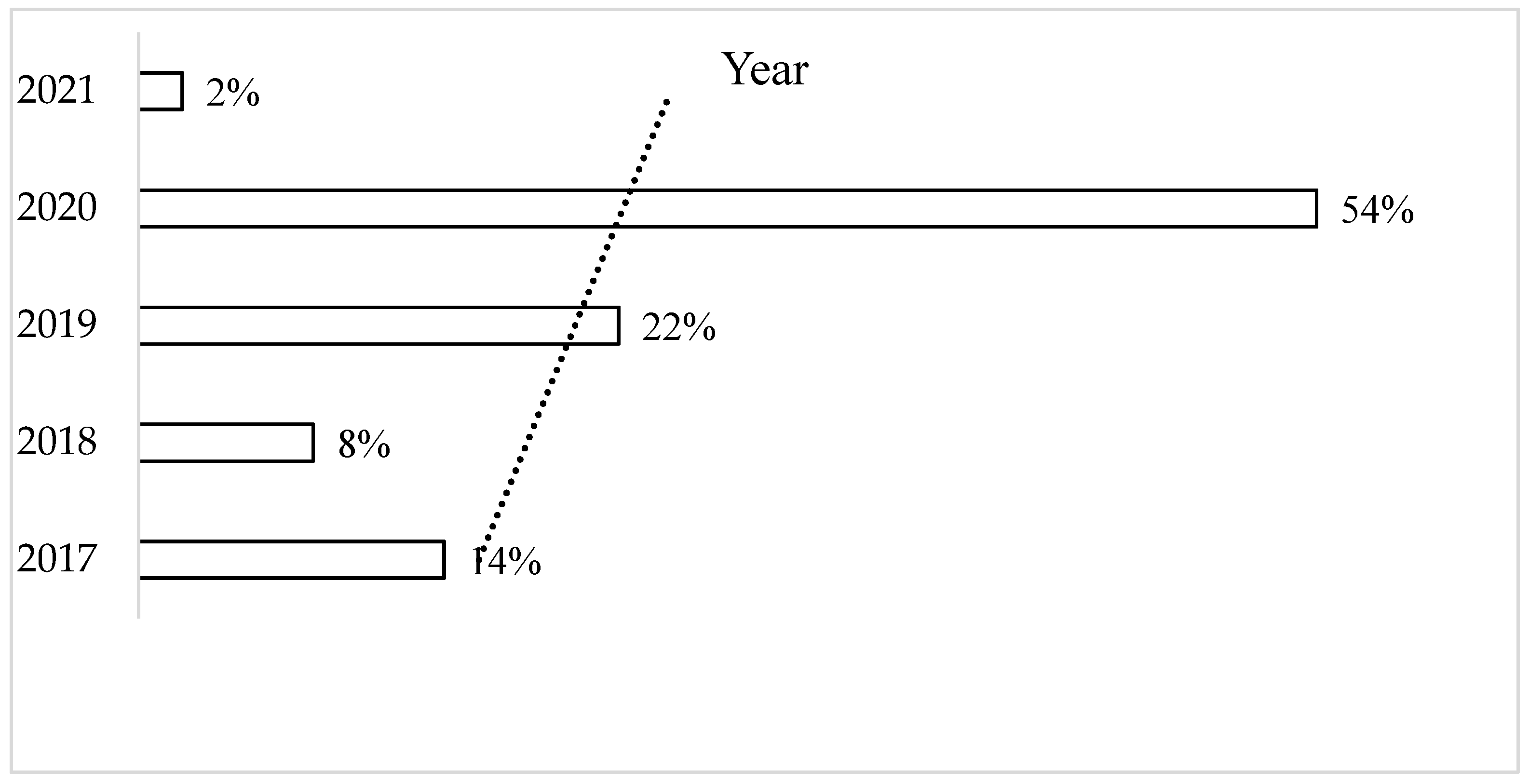
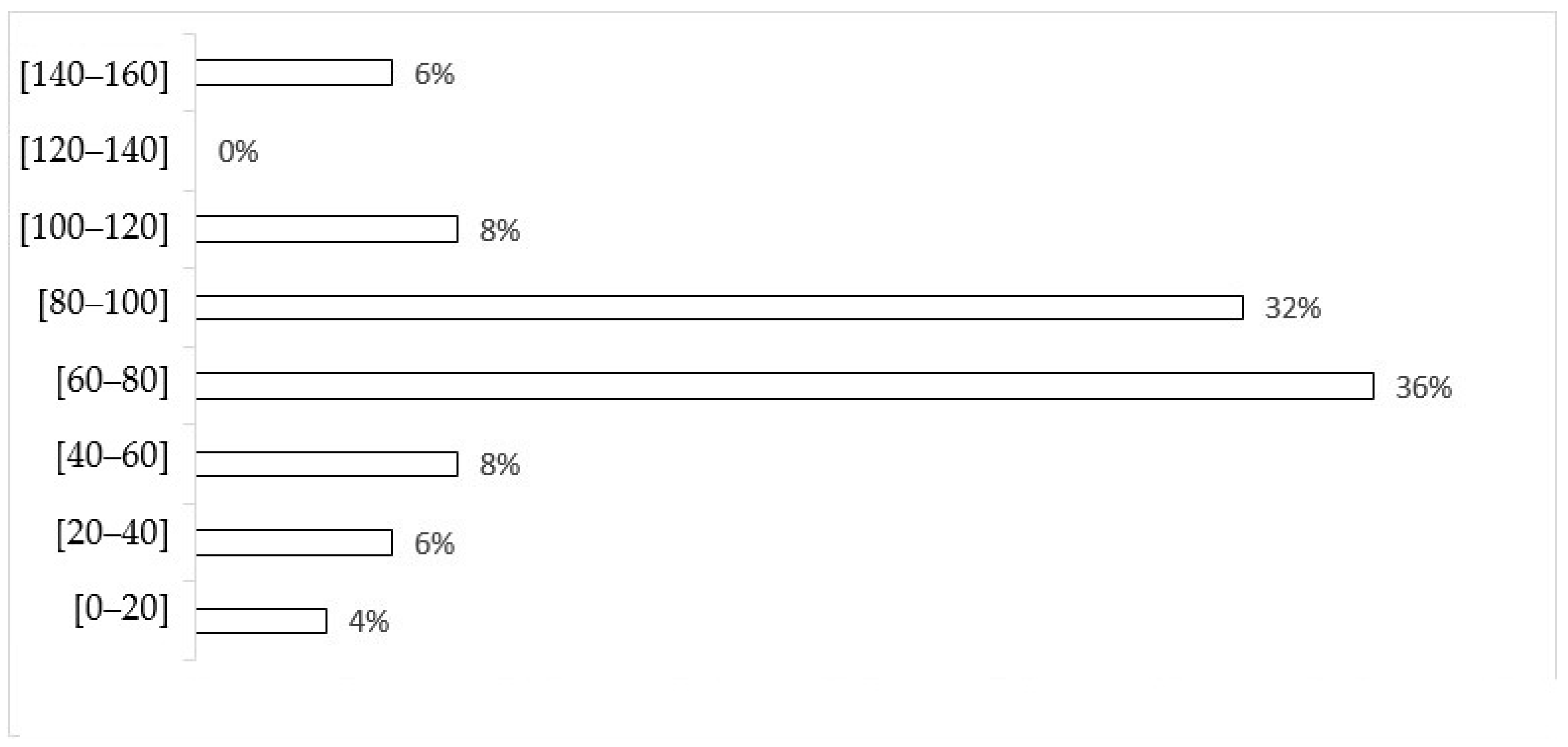

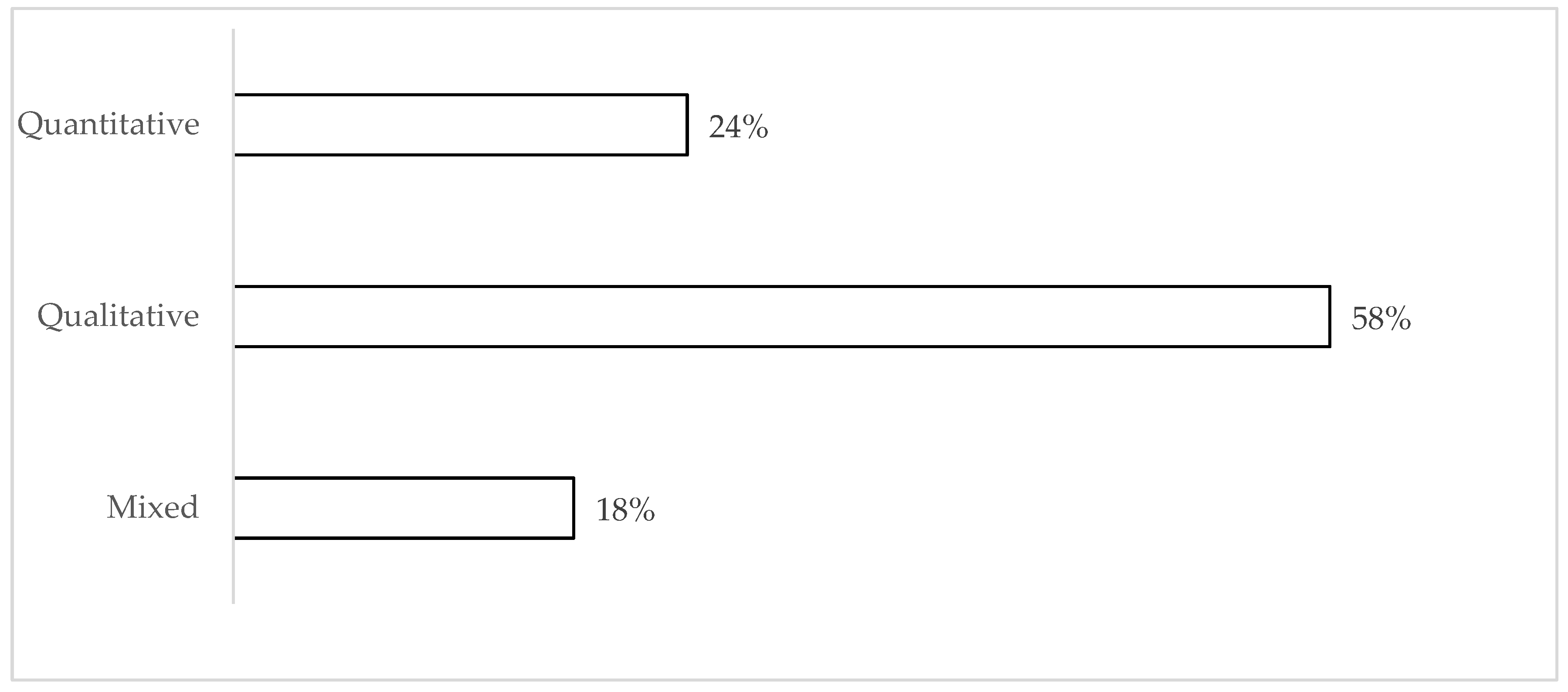
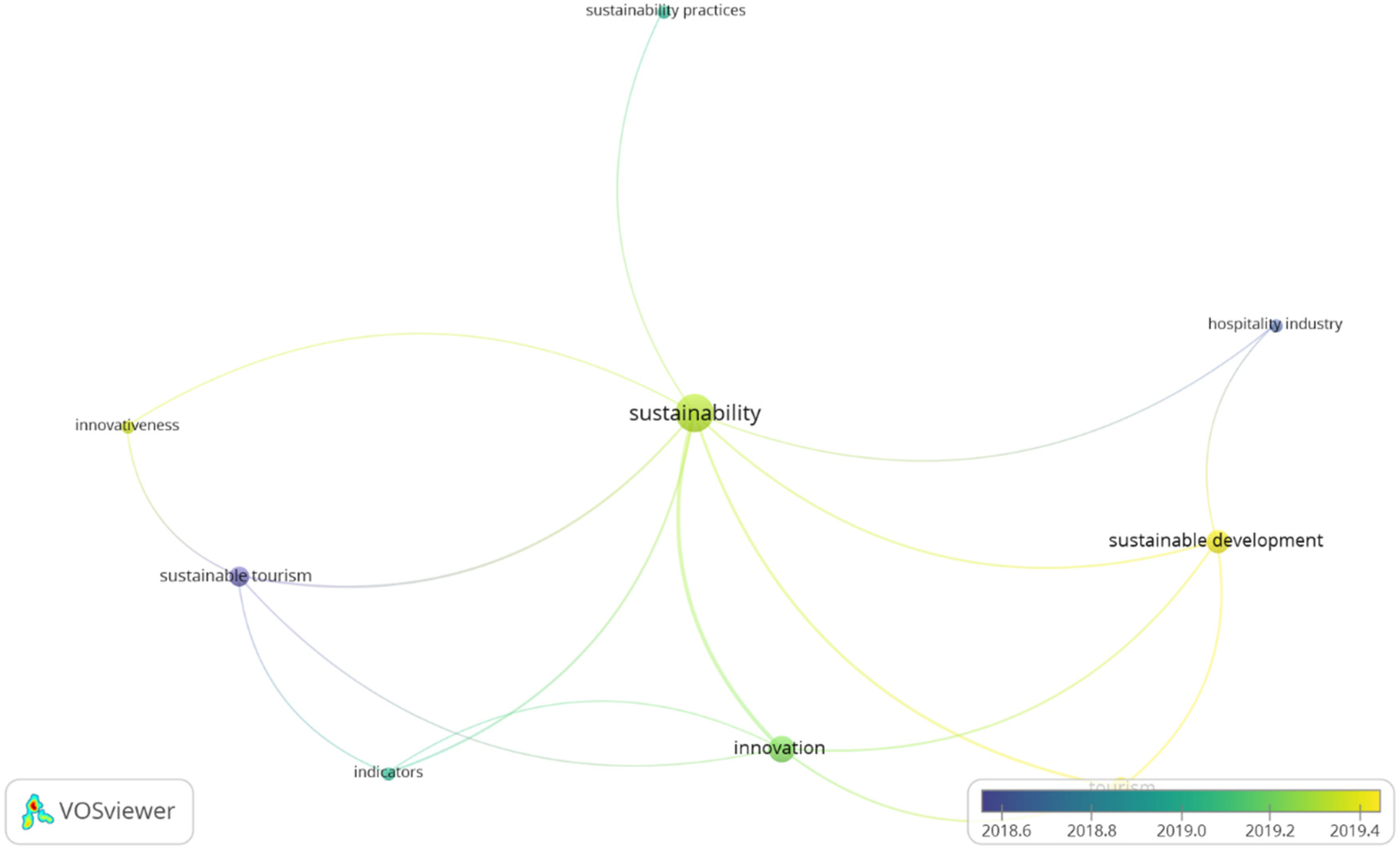
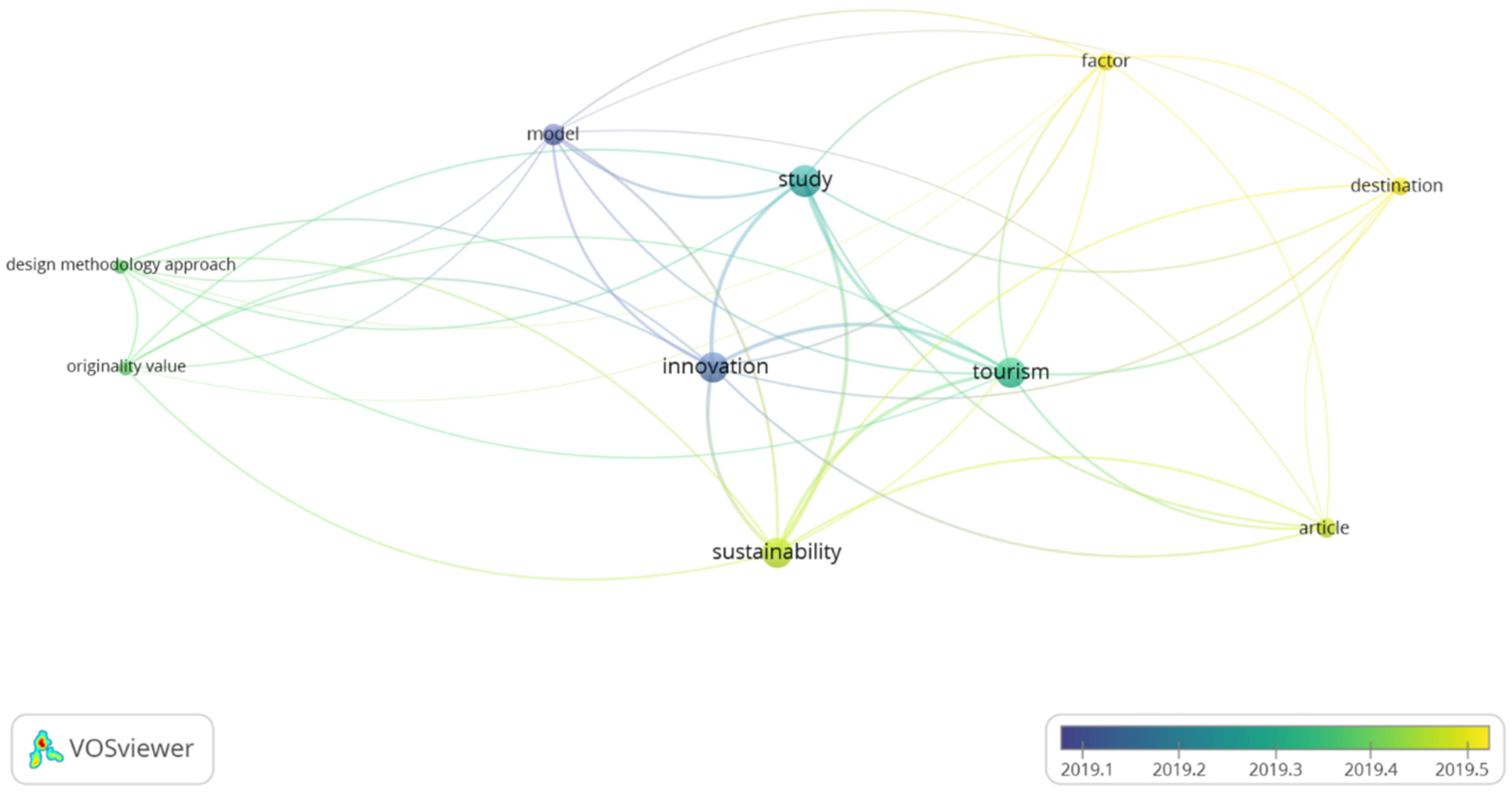
| Journal | Number of Publications Per Journal |
|---|---|
| Bottom Line | 1 |
| European Planning Studies | 1 |
| International Journal of Contemporary Hospitality Management | 2 |
| International Journal of Cultural Policy | 1 |
| International Journal of Environmental Research and Public Health | 1 |
| International Journal of Hospitality Management | 3 |
| International Journal of Innovation and Sustainable Development | 1 |
| International Journal of Management Education | 1 |
| International Journal of Tourism Research | 1 |
| Journal for International Business and Entrepreneurship Development | 1 |
| Journal of Cleaner Production | 2 |
| Journal of Cultural Heritage Management and Sustainable Development | 1 |
| Journal of Family Business Management | 1 |
| Journal of Hospitality & Tourism Research | 1 |
| Journal of Hospitality and Tourism Management | 1 |
| Journal of Sustainable Tourism | 9 |
| Journal of Travel Research | 1 |
| Communication Journal of SEECI | 1 |
| Sustainability | 9 |
| Sustainable Development | 2 |
| Tourism Analysis | 1 |
| Tourism Management | 1 |
| Tourism Management Perspectives | 1 |
| Tourism Planning & Development | 1 |
| Tourism Recreation Research | 1 |
| Tourism Review | 1 |
| Worldwide Hospitality and Tourism Themes | 3 |
| 50 |
| Location | Number of Publications Per Location Where the Survey Was Conducted |
|---|---|
| Australia | 1 |
| Bangladesh | 1 |
| Costa Rica | 1 |
| Dominican Republic | 1 |
| Finland | 1 |
| Germany | 1 |
| Greece | 2 |
| Italy | 2 |
| Malaysia | 2 |
| Mexico | 1 |
| Multinational | 24 |
| Netherlands | 1 |
| Portugal | 2 |
| South Korea | 1 |
| Spain | 8 |
| Taiwan | 1 |
| Sustainability | Innovation |
|---|---|
|
|
Publisher’s Note: MDPI stays neutral with regard to jurisdictional claims in published maps and institutional affiliations. |
© 2021 by the authors. Licensee MDPI, Basel, Switzerland. This article is an open access article distributed under the terms and conditions of the Creative Commons Attribution (CC BY) license (https://creativecommons.org/licenses/by/4.0/).
Share and Cite
Santos, V.; Sousa, M.J.; Costa, C.; Au-Yong-Oliveira, M. Tourism towards Sustainability and Innovation: A Systematic Literature Review. Sustainability 2021, 13, 11440. https://doi.org/10.3390/su132011440
Santos V, Sousa MJ, Costa C, Au-Yong-Oliveira M. Tourism towards Sustainability and Innovation: A Systematic Literature Review. Sustainability. 2021; 13(20):11440. https://doi.org/10.3390/su132011440
Chicago/Turabian StyleSantos, Vasco, Maria José Sousa, Carlos Costa, and Manuel Au-Yong-Oliveira. 2021. "Tourism towards Sustainability and Innovation: A Systematic Literature Review" Sustainability 13, no. 20: 11440. https://doi.org/10.3390/su132011440
APA StyleSantos, V., Sousa, M. J., Costa, C., & Au-Yong-Oliveira, M. (2021). Tourism towards Sustainability and Innovation: A Systematic Literature Review. Sustainability, 13(20), 11440. https://doi.org/10.3390/su132011440









